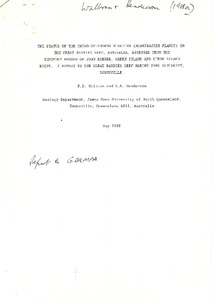Please use this identifier to cite or link to this item:
https://hdl.handle.net/11017/3782

Full metadata record
| DC Field | Value | Language |
|---|---|---|
| dc.contributor.author | Walbran, P.D. | - |
| dc.contributor.author | Henderson, R.A. | - |
| dc.coverage.spatial | Heron Island | en |
| dc.coverage.spatial | Green Island | en |
| dc.coverage.spatial | John Brewer Reef | en |
| dc.date.accessioned | 2021-03-08T01:22:31Z | - |
| dc.date.available | 2021-03-08T01:22:31Z | - |
| dc.date.copyright | 1988 | en |
| dc.date.issued | 1988 | en |
| dc.identifier.uri | https://hdl.handle.net/11017/3782 | - |
| dc.description.abstract | [Extract from 1988 report] Over the last 30 years the crown-of-thorns starfish (Acanthaster planci) has caused extensive damage to many reefs in the Great Barrier Reef Province. John Brewer Reef and Green Island Reef are among those worst affected by A. planci predation during this period. Surface sediment from these two reefs was exhaustively picked for A. planci skeletal elements and found to be greatly enhanced in element abundance when compared to that of Heron Island Reef which has historically maintained very low-density starfish populations. Carbon-14 accelerator mass spectrometry (AMS) dating indicates that skeletal elements from the surface sediment of John Brewer and Green Island Reefs are of contemporary age. Core sampling shows that subsurface sediment at John Brewer and Green Island Reefs contains A. planci element densities comparable to those found in the surface sediment at these localities. Physical and biological reworking of elements within the sediment precludes the recognition of individual outbreaks in core stratigraphy. AMS element dates and bulk sediment dates, obtained by conventional Carbon-14 radiometry, show that subsurface elements are generally prehistoric and conform to an age structure preserved in the sediment pile. Assessed on a time-averaged basis, the density and distribution of subsurface elements suggest that A. planci outbreaks are not a recent phenomenon, but have been an integral part of the ecosystem for at least 7,000 years on John Brewer Reef and 3,000 years on Green Island Reef. | en |
| dc.publisher | James Cook University of North Queensland | en |
| dc.relation.ispartofseries | Report to the Great Barrier Reef Marine Park Authority | en |
| dc.subject.other | Reef Ecosystems & Marine Species | en |
| dc.title | The status of the crown-of-thorns starfish (Acanthaster planci) in the Great Barrier Reef, Australia, assessed from the sediment record of John Brewer, Green Island and Heron Island reefs | en |
| dc.type | Report | en |
| dc.subject.asfa | Predation | en |
| dc.subject.asfa | Sediment analysis | en |
| dc.format.pages | 38 | en |
| dc.publisher.place | Townsville | en |
| dc.relation.connectiontogbrmpa | GBRMPA contributed to this item | en |
| dc.subject.location | Townsville/Whitsunday Management Area | en |
| dc.subject.location | Mackay/Capricorn Management Area | en |
| dc.keywords | COTS | en |
| Appears in Collections: | Ecosystems | |
Files in This Item:
| File | Description | Size | Format | |
|---|---|---|---|---|
| 1988-Status-Crown-of-Thorns-A-Planci-Assessed-Sediment-Record.pdf | Main report (PDF) | 21.14 MB | Adobe PDF |  View/Open |
Items in ELibrary are protected by copyright, with all rights reserved, unless otherwise indicated.
